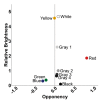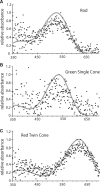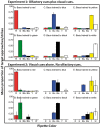Seeing red: color vision in the largemouth bass
- PMID: 30697237
- PMCID: PMC6347066
- DOI: 10.1093/cz/zoy019
Seeing red: color vision in the largemouth bass
Abstract
How animals visually perceive the environment is key to understanding important ecological behaviors, such as predation, foraging, and mating. This study focuses on the visual system properties and visual perception of color in the largemouth bass Micropterus salmoides. This study (1) documents the number and spectral sensitivity of photoreceptors, (2) uses these parameters to model visual perception, and (3) tests the model of color perception using a behavioral assay. Bass possess single cone cells maximally sensitive at 535 nm, twin cone cells maximally sensitive at 614 nm, and rod cells maximally sensitive at 528 nm. A simple model of visual perception predicted that bass should not be able to discern between chartreuse yellow and white nor between green and blue. In contrast, bass should be able to discern red from all achromatic (i.e., gray scale) stimuli. These predictions were partially upheld in behavioral trials. In behavioral trials, bass were first trained to recognize a target color to receive a food reward, and then tested on their ability to differentiate between their target color and a color similar in brightness. Bass trained to red and green could easily discern their training color from all other colors for target colors that were similar in brightness (white and black, respectively). This study shows that bass possess dichromatic vision and do use chromatic (i.e., color) cues in making visual-based decisions.
Keywords: bass; cones; photoreceptors; rods; vision.
Figures





Similar articles
-
Differential distributions of red-green and blue-yellow cone opponency across the visual field.Vis Neurosci. 2002 Jan-Feb;19(1):109-18. doi: 10.1017/s0952523802191103. Vis Neurosci. 2002. PMID: 12180855
-
The spatial tuning of achromatic and chromatic vision in budgerigars.J Vis. 2011 Jun 2;11(7):2. doi: 10.1167/11.7.2. J Vis. 2011. PMID: 21636524
-
The simple perfection of quantum correlation in human vision.Prog Neurobiol. 2006 Jan;78(1):38-60. doi: 10.1016/j.pneurobio.2005.11.006. Epub 2005 Dec 27. Prog Neurobiol. 2006. PMID: 16377059 Review.
-
Responses of primate retinal ganglion cells to moving spectral contrast.Vision Res. 1983;23(10):1175-82. doi: 10.1016/0042-6989(83)90031-7. Vision Res. 1983. PMID: 6649436
-
Adaptive plasticity during the development of colour vision.Prog Retin Eye Res. 2005 Jul;24(4):521-36. doi: 10.1016/j.preteyeres.2005.01.002. Prog Retin Eye Res. 2005. PMID: 15845347 Review.
Cited by
-
Anatomy, ultrastructure and histology of the olfactory organ of the largemouth bass Micropterus salmoides, Centrarchidae.Appl Microsc. 2019 Dec 23;49(1):18. doi: 10.1186/s42649-019-0023-3. Appl Microsc. 2019. PMID: 33580339 Free PMC article.
-
Color preferences affect learning in zebrafish, Danio rerio.Sci Rep. 2019 Oct 10;9(1):14531. doi: 10.1038/s41598-019-51145-5. Sci Rep. 2019. PMID: 31601932 Free PMC article.
-
The pervasive effects of lighting environments on sensory drive in bluefin killifish: an investigation into male/male competition, female choice, and predation.Curr Zool. 2018 Aug;64(4):499-512. doi: 10.1093/cz/zoy038. Epub 2018 May 31. Curr Zool. 2018. PMID: 30108631 Free PMC article.
-
Plasticity of opsin gene expression in the adult red shiner (Cyprinella lutrensis) in response to turbid habitats.PLoS One. 2019 Apr 12;14(4):e0215376. doi: 10.1371/journal.pone.0215376. eCollection 2019. PLoS One. 2019. PMID: 30978235 Free PMC article.
-
Robust Sensory Traits Across Light Habitats: Visual Signals but Not Receptors Vary in Centrarchids Inhabiting Distinct Photic Environments.Mol Ecol. 2025 Apr;34(8):e17721. doi: 10.1111/mec.17721. Epub 2025 Mar 11. Mol Ecol. 2025. PMID: 40066691 Free PMC article.
References
-
- Aksnes D, Utne ACW, 1997. A revised model of visual range in fish. Sarsia 82:37–41.
-
- Ali MA, Anctil M, 1976. Retinas of Fishes: An Atlas. Berlin: Springer-Verlag.
-
- Baldwin J, Johsnen S, 2012. The male blue crab, Callinectes sapidus, uses both chromatic and achromatic cues during mate choice. J Exp Biol 215:1184–1191. - PubMed
-
- Boughman JW, 2002. How sensory drive can promote speciation. Trends Ecol Evol 17:571–577.
-
- Bridges CDB, 1972. Photochemistry of Vision. New York: Springer-Verlag.
LinkOut - more resources
Full Text Sources
